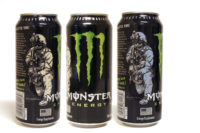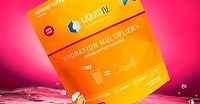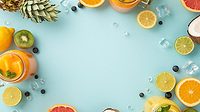Energy market expands from function to flavor
Energy segment innovates to expand usage


Better-for-you energy shots, such as all-natural Celestial Seasonings Kombucha Energy Shots, are helping the energy category to broaden its appeal, according to Innova Market Insights’ Natalie Tremellen. (Image courtesy of The Hain Celestial Group)

Energy drink mixes are the fastest-growing part of the energy segment, Mintel’s Jennifer Zegler says. (Image courtesy of NVE Pharmaceuticals Inc.)







As Farmington Hills, Mich.-based Living Essentials LLC’s 5 Hour Energy brand suggests in its advertising, “that 2:30 feeling” can be difficult for many consumers to overcome. In fact, that mid-afternoon slump, or “post-lunch dip,” is a natural part of humans’ internal clock, which creates the urge to sleep approximately seven hours after waking, according to a 2007 New York Times article. As a result, many consumers might turn to energy drinks or shots for an afternoon pick-me-up. According to data from Mintel, 42 percent of people who drink energy shots take them in the afternoon, and 49 percent of people who consume energy drinks do so in the afternoon, says Jennifer Zegler, beverage analyst at the Chicago-based market research firm.
| Jump to: |
However, the consumption occasion for energy drinks is changing, says Jonas Feliciano, beverage analyst for Euromonitor International, Chicago. When energy drinks were first introduced in the United States, they were positioned as lifestyle beverages and often were mixed with alcohol, he says. In recent years, energy drink manufacturers have moved away from this positioning and grown the category in terms of function, flavor and hybridization, he adds.
Expanding with flavor
The success of 5 Hour Energy, which remains the leader in the energy shot segment, and its primary focus on the function of energy has helped to broaden the consumer base for energy drinks, Feliciano says. Energy shots typically are targeted at older consumers who need an energy boost at the office or before a workout, Euromonitor beverage analyst Chris Schmidt adds. By using this same function, energy drinks can tap into that consumer segment to expand the category's usage, Feliciano says.
Plus, energy drink manufacturers now are moving past function and exploring different flavors, natural formulations and categories, such as carbonated soft drinks (CSDs) and tea, which are providing options outside of the “2:30” time frame, he notes.
Earlier this year, Santa Monica, Calif.-based Red Bull North America Inc. created its first flavored energy drinks with its Editions platform. The line is available in cranberry, lime and blueberry flavors. Last year, Las Vegas-based Rockstar International launched Rockstar SuperSours in Bubbleberry and Sour Apple flavors.
“Taste has become an increasingly important purchasing factor; it’s not surprising. Consumers just aren’t happy with one generic flavor; it has to taste good, too.” |
Furthermore, Corona, Calif.-based Monster Beverage Corp.’s coffee-flavored Java Monster energy drink grew nearly 18 percent in the 52 weeks ending June 16 in supermarkets, drug stores, mass market retailers, gas and convenience stores, military commissaries, and select club and dollar retail chains compared with the prior-year period, according to data from Information Resources Inc. (IRI), a Chicago-based market research firm.
In general, energy drink flavors are becoming more sophisticated, notes Natalie Tremellen, market analyst for Innova Market Insights, the Netherlands. The use of superfruit and berry flavors, in particular, are gaining momentum, she says.
This trend also can be seen among energy shots. Last year, Birmingham, Mich.-based On Go Energy introduced energy shots in Berry Blast and Pomegranate Blueberry flavors as well as Lemon Lime, Mandarin Orange, Grape and Fruit Punch flavors.
“The initial novelty of the energy shot has worn off,” said Derrick George, founder and chief executive officer of On Go Energy, in a statement. “Taste has become an increasingly important purchasing factor; it’s not surprising. Consumers just aren’t happy with one generic flavor; it has to taste good, too.”
A healthy shift
On the natural front, ingredients such as coconut water and fruit juice are being used to supply “healthy energy” with more natural-sounding fruit flavors used for flavor names, Innova’s Tremellen says. For instance, Rockstar launched Rockstar Energy + Hydration Coconut Water Energy Drink, which is a non-carbonated energy drink made with 10 percent coconut water, she explains. Additionally, Seattle-based Starbucks offers Starbucks Refreshers in Strawberry Lemonade, Raspberry Pomegranate and Orange Melon flavors featuring the natural energy alternative green coffee extract.
“Due to the adoption of more natural, functional ingredients and real fruit flavors, energy drinks in particular are broadening their appeal to a wider range of consumers than ever before,” Tremellen says. “There has also been considerable packaging innovation — a gradual shift from predominantly black cans in which energy drinks have been traditionally associated to the use of white cans, which, along with natural flavors, ingredients, etc., convey more wellness and better-for-you attributes.”
The trend toward more natural ingredients also applies to energy shots, she notes. Within this segment, ingredients like kombucha and beetroot are being used for functional claims, she says. Melville, N.Y.-based The Hain Celestial Group, for example, launched a line of kombucha shots under its Celestial Seasonings brand with natural energy ingredients. Celestial Seasonings Pomegranate Xtreme Kombucha Energy Shot contains raw kombucha, guarana, ginseng and B vitamins to supply energy, Tremellen says. New York-based SK Energy LLC, a PureGrowth Partners portfolio company, offers its SK Energy brand, which was formerly known as Street King. The company uses the product's packaging to call out the product's 100 percent natural flavors and antioxidants. The shots also are sugar- and calorie-free. In the 52 weeks ending June 16 in IRI-measured channels, the brand increased almost 630 percent compared with the prior-year period, according to IRI data.
Sugar-free and calorie-free energy drinks and shots are a notable trend in the category, according to experts. Red Bull Total Zero, which launched last year, increased 318 percent in the 52 weeks ending June 16 compared with the prior-year period, according to IRI data. The product does not contain any calories, sugar or carbohydrates. Likewise, sugar-free, calorie-free Monster Absolutely Zero increased 72 percent in IRI-measured channels during the time frame, the market research firm reports. Rockstar also recently launched Rockstar Pure Zero in Silver Ice and Punched flavors featuring zero calories and no sugar.
Blurring the lines
Capitalizing on the success of other beverage categories, hybrid energy drinks also are expanding the category’s usage occasions, Euromonitor’s Feliciano says. Purchase, N.Y.-based PepsiCo’s new Kickstart beverage dips into the energy, juice drink and CSD categories, and Monster Beverage Corp.’s Monster Rehab line is capitalizing on the popularity of ready-to-drink (RTD) teas with its tea flavors, experts say. Monster Rehab, in particular, is proving the success of blurring category lines, Feliciano says. The brand increased nearly 40 percent in measured channels for the 52 weeks ending June 16 compared with the prior-year period, according to IRI data.
It’s common to find energy drinks at on-premise locations such as bars or nightclubs, but now they can be found at foodservice locations, Feliciano notes. “There’s a greater acceptance from society to drink energy drinks as a part of lunch or as part of dinner or even that midday boost without receiving the ridicule that some consumers may have had in the past,” he says.
In the news
Despite the energy category’s ongoing growth, critical media attention is keeping many consumers away, Mintel’s Zegler says. According to Mintel research, the top reasons that consumers do not drink energy drinks and shots are: “I do not feel I need them,” “They are not good for my health,” and “I have heard the negative information about their health effects,” she says. Of the people who do consume energy drinks and/or shots, 11 percent are drinking fewer energy drinks compared with a year ago, and 8 percent are taking fewer energy shots compared with a year ago, she adds. Nevertheless, most energy drink and shot consumers are keeping their consumption habits the same,
she notes.
For consumers who are concerned about the health effects of energy drinks, portion-controlled packaging might be an option to keep them in the category, Zegler suggests. According to Mintel research, 73 percent of respondents agree that companies should include recommended daily consumption limits on the packaging of their energy drinks and/or shots. This could mean simply adding that information to the label on a can, but it also could create a need for portion-controlled packaging, she explains.
Mintel’s carbonated soft drinks report from June 2013 shows that portion-controlled packaging has been embraced by 18 to 24 year olds, which is a group of consumers that overlaps with energy drink usage, Zegler points out.
Energy mixes might also benefit the energy category because they allow consumers to customize the flavor and strength of their beverages, which could appeal to consumers who are concerned about the safety of energy drinks, she adds.
Energizing the future
From 2011 to 2012, the energy drink segment increased 16.6 percent for $8.6 billion in sales, and the energy shot segment increased 18 percent for $1.5 billion in sales, according to Euromonitor data. Globally, energy drink launches increased 32 percent, and energy shot launches increased 29 percent from 2011 to 2012, according to Innova. However, Mintel’s August 2013 report on energy drinks states that sales of energy shots in the United States slowed to 5 percent growth in 2012, Zegler says. The market research firm forecasts the segment to decline 6 percent in 2013; however, it expects the energy drinks segment to increase 16.4 percent, she says.
Both energy drinks and shots are on a steady path for growth, according to the January 2013 “Energy Drinks and Shots in the U.S.” report from Packaged Facts, Rockville, Md. Although the market has experienced a natural slowdown in its rate of growth, this indicates that it is becoming more mature, it states.
“[Energy] shots are the segment that’s forecast to fare the worst throughout this period,” Mintel’s Zegler says. “It’s still going to have some struggles going forward, we feel. But what’s interesting is that the energy mixes segment, which used to be a very small portion of the market, … is proving to be the fastest-growing category in the energy segment.” The energy mix segment grew nearly 187 percent from 2011 to 2012, she notes.
Brands like Northfield, Ill.-based Kraft Foods Group Inc.’s Mio Energy and Crystal Light Energy are leading the category, she says. Building off of its Stacker2 brand, Andover, N.J.-based NVE Pharmaceuticals Inc. launched Stacker2 Energy Enhanced Flavor Drops in February. The company’s Stacker2 Xtra, Stacker2 6 Hour Power and Stacker2 energy shots landed in three of the Top 5 positions on IRI’s top energy shots list for the 52 weeks ending June 16.
Growth in the energy drink mix category provides evidence that innovation can drive sales in the energy segment, according to Packaged Facts’ report.
Looking for a reprint of this article?
From high-res PDFs to custom plaques, order your copy today!











